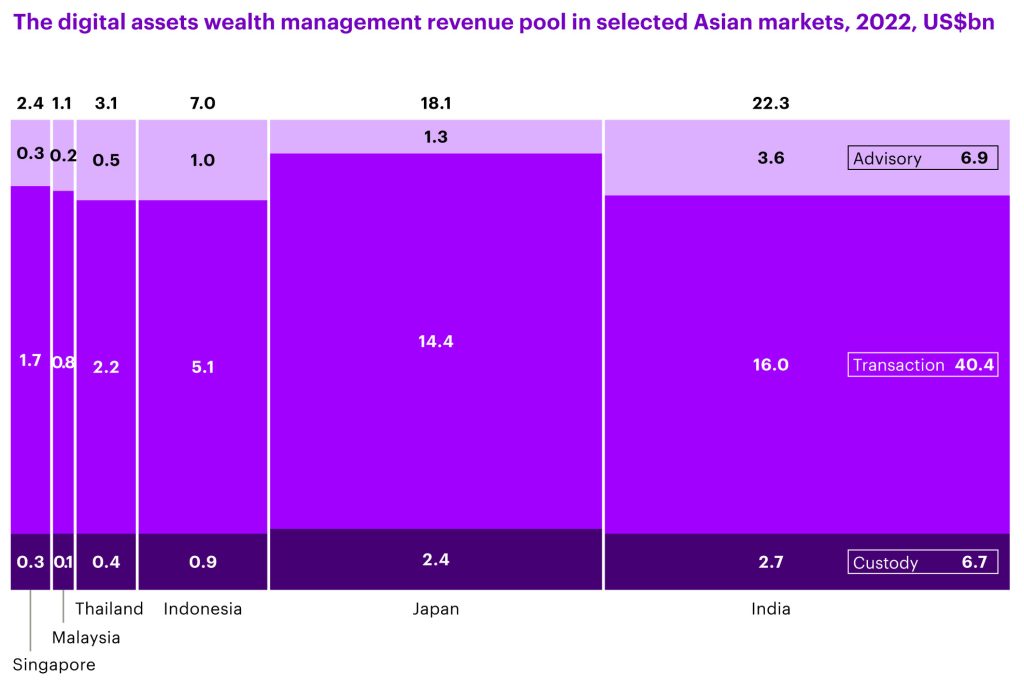In recent weeks, an array of bad-news stories has led some commentators to predict the demise of cryptocurrencies and other digital assets. These stories include the collapse of the algorithmic stablecoin USTC and its sister token LUNA—costing investors tens of billions of dollars1—and the decision by cryptocurrency lending platform Celsius Networks to suspend withdrawals2. The value of Bitcoin fell as low as US$17,600 in June 2022, down from US$69,000 in late 2021. As Bitcoin goes, so do its crypto peers. By June, cryptocurrency’s market capitalization had slumped to around US$930bn,3 far below its US$3trn high in 2021.4
The main question I’m being asked since the release of our report Digital assets: Unclaimed territory is whether this recent bad news means digital assets are now an asset class that wealth management firms can ignore. If firms want to achieve their growth ambitions in Asia for 2025 (as laid out by many on various occasions), my answer remains an unambiguous “no”.
Why a focus on digital assets remains important
First, Bitcoin and other cryptocurrencies do not comprise the entire digital asset class; they are just one component. Other digital assets are stablecoins, crypto funds, security tokens and asset-backed tokens, and client demand for these remains quite strong.
Second, cryptocurrency is not the only market that has had a difficult year so far. Everything has. The S&P500, for example, has dropped more than 20 percent since the start of the year (by end of June 2022), but you won’t find wealth managers shying away from offering exposure to the main US index because of that. While markets globally are in retreat, history shows they are likely to recover—and there is little reason to expect that the broader digital assets class will fare differently.
About half of Asian affluent investors already hold digital assets
The third reason is that digital assets in Asia are a fast-growing asset class and—as our research shows—an underappreciated opportunity for proactive wealth managers: two-thirds of wealth management firms in Asia have no plans to offer their affluent clients any exposure to digital assets, even though most clients either have exposure or want it.
Indeed, as our report found, digital assets are the fifth most popular asset class for affluent investors in Asia, behind only equities, fixed income, cash and real estate. By the end of last year, Asia’s affluent investors allocated seven percent of their portfolios to digital assets. And while younger investors are more exposed, the trend is largely consistent across markets, wealth bands and genders.
Fourth, even if recent market moves mean investors’ allocations are down to, say, five percent, digital assets would still comprise a major asset class—and wealth management firms should be able to cater to their clients’ needs in this regard, just as they would for any comparably important investment.
The fifth reason is growth: about half of affluent investors in Asia held digital assets last year, and we expect this proportion could reach nearly three-quarters by the end of 2022. While client demand offers sound reasons for wealth management firms to offer digital assets propositions, there are also revenue and strategic considerations which should encourage firms to do so—despite the current cryptocurrency downturn.
Digital assets represent a large revenue potential
One part of this is that—according to our estimates—digital assets could constitute a US$54bn revenue pool—made up principally of transaction revenues (see Figure 1)—yet are being largely ignored by wealth management firms.
Figure 1: The digital assets wealth management revenue pool in selected Asian markets, 2022, US$bn

Source: Accenture Analysis, 2022. Note that China (mainland) and China (Hong Kong SAR) were excluded for regulatory feasibility reasons, given bans on cryptocurrency. Note: Potential revenue pool estimated in Q1 2022 for the full year
It is also because, as we’ve seen, affluent clients want access to this asset class, and firms that provide it are more likely to retain existing clients and attract new investors—not least the generation of younger investors on the cusp of inheriting significant wealth.
Finally, and perhaps most importantly, our research shows that firms’ relationship managers (RMs) want to be able to offer their clients exposure to digital assets. As the battle for RMs heats up in the coming years (explored in another of our new reports, Empowering relationship managers: The tools they need to succeed), firms that provide what RMs require will be best-placed to succeed in the increasingly competitive world of wealth management—in which a digital assets proposition would constitute a core offering.
So, despite the cryptocurrency slump, I believe the message around digital assets overall remains the same: wealth managers in Asia need a digital assets strategy, or they risk falling behind those of their peers that are already starting to plan for any market upturn.











